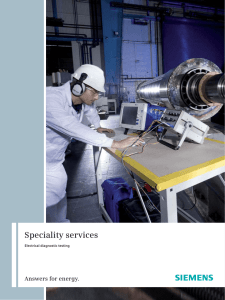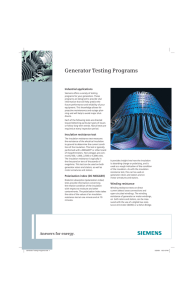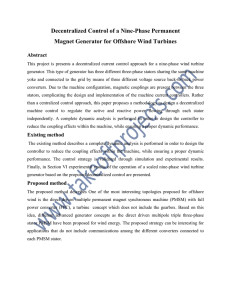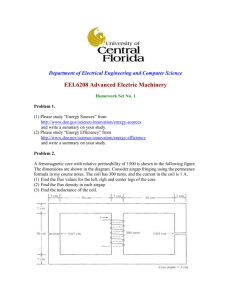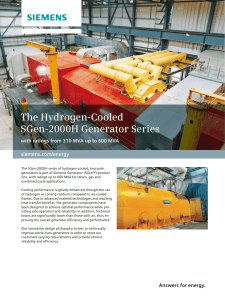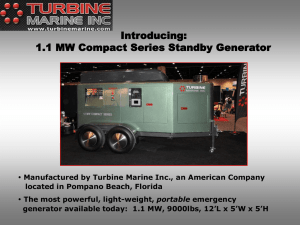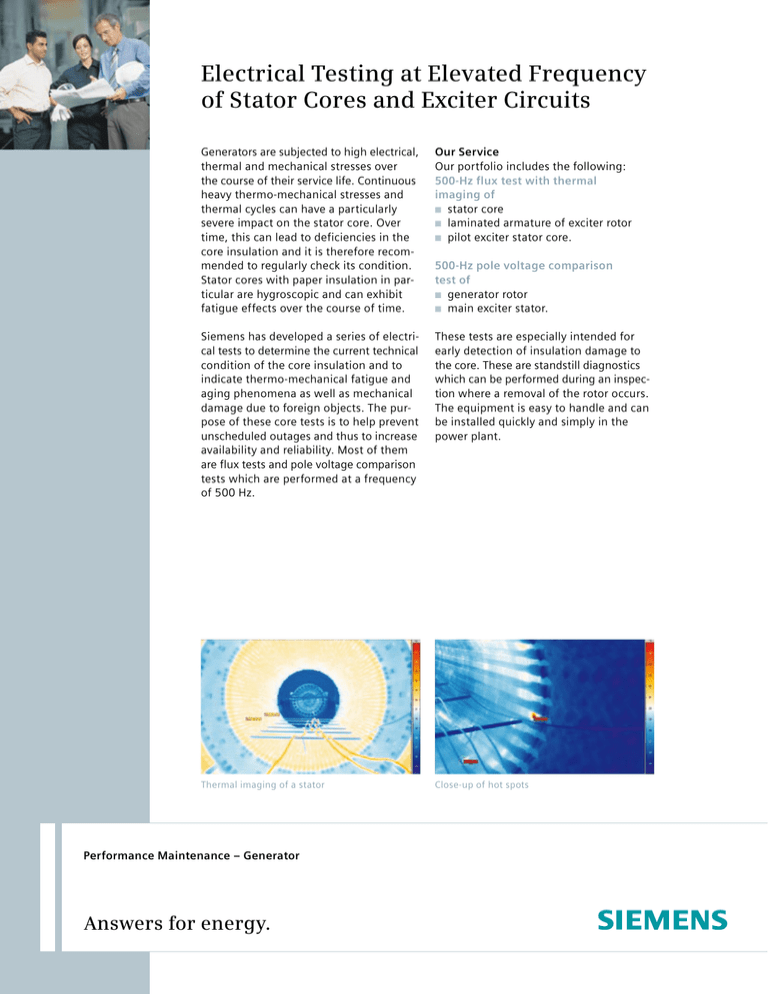
Electrical Testing at Elevated Frequency
of Stator Cores and Exciter Circuits
Generators are subjected to high electrical,
thermal and mechanical stresses over
the course of their service life. Continuous
heavy thermo-mechanical stresses and
thermal cycles can have a particularly
­severe impact on the stator core. Over
time, this can lead to deficiencies in the
core insulation and it is therefore recommended to regularly check its condition.
Stator cores with paper insulation in particular are hygroscopic and can exhibit
­fatigue effects over the course of time.
Our Service
Our portfolio includes the following:
500-Hz flux test with thermal
imaging of
■■ stator core
■■ laminated armature of exciter rotor
■■ pilot exciter stator core.
Siemens has developed a series of electrical tests to determine the current technical
condition of the core insulation and to
­indicate thermo-mechanical fatigue and
aging phenomena as well as mechanical
damage due to foreign objects. The purpose of these core tests is to help prevent
unscheduled outages and thus to increase
availability and reliability. Most of them
are flux tests and pole voltage comparison
tests which are performed at a frequency
of 500 Hz.
These tests are especially intended for
early detection of insulation damage to
the core. These are standstill diagnostics
which can be performed during an inspection where a removal of the rotor o
­ ccurs.
The equipment is easy to handle and can
be installed quickly and simply in the
power plant.
Thermal imaging of a stator
Close-up of hot spots
Performance Maintenance – Generator
Answers for energy.
500-Hz pole voltage comparison
test of
■■ generator rotor
■■ main exciter stator.
Features
500-Hz flux test with thermal imaging
The 500-Hz flux test with thermal imaging
patented by Siemens already has a proven
track record in the field of generator stator
core testing. It has now also been further
developed for exciters.
This examination method is used for
­evaluating generator stator cores as well
as for pilot exciters and the laminated
­armature of exciter rotors. The flux test
is used to measure the condition of the
stator core insulation and thus to detect
possible local insulation damage. Insulation failure can result in local hot spots
between several sheets of the core during
magnetization. These hot spots can be
detected and localized with thermal
­imaging.
The measurement is performed at a frequency of 500 Hz, as significantly lower
power is required at high frequency than
at grid frequency (50 or 60 Hz) to generate equivalent magnetization losses in
the stator core. However, since the stress
on the insulation between the laminations
is comparable, the integrity of the core
can be evaluated just as effectively. The
requisite instrumentation is also considerably smaller and lighter in comparison
with that needed for 50 Hz testing. This
helps shorten test duration and assembly
of the test setup. The system is more
transportable and simpler to implement
worldwide.
500-Hz pole voltage comparison test
This measurement is performed on the
generator rotor winding as well as on
the stator winding of the main exciter.
By comparing the measured voltages
across each pole it is possible to detect
interturn faults in DC windings. This is
done by applying a sinusoidal voltage to
the winding and measuring the resulting
voltage drops with a voltage meter. If the
voltage drops are essentially equivalent,
there is no interturn fault. If the test results
Published by and copyright © 2011:
Siemens AG
Energy Sector
Freyeslebenstrasse 1
91058 Erlangen, Germany
Siemens Energy, Inc.
4400 Alafaya Trail
Orlando, FL 32826-2399, USA
www.siemens.com/energy
are outside the specified tolerance limits,
this indicates an interturn fault. The sensitivity and the localization accuracy of
the 500-Hz pole voltage comparison test
are especially high for low-resistance or
metallic interturn faults.
Your Benefits
The measurements to establish the integrity of the stator core or exciter system
can be performed during an outage with
rotor removal. Our specialists analyze
the localized indications and recommend
measures for future operation. This can
help improve operating reliability and
availability and reduce the risk of developing hot spots in the generator. In extreme
cases, these hidden operating risks can
result in sudden loss of individual parts,
components or even the entire generator.
If deficiencies are detected, measures
can be implemented during the ongoing
inspection, such as replacing or repairing
the affected components. These measurements have been included in Siemens’
standard measures in new generator
manufacture as well as in Field Service
since 2004. 500-Hz flux test as well as
the 500-Hz pole voltage comparison
test of generator components has been
recommended by industry groups.
In addition to the 500-Hz measurements,
the following measurements can also be
performed on the generator:
■■ Recurrent Surge Oscillography (RSO)
of the rotor to detect interturn faults
■■ Insulation resistance measurement
(RISO) of all windings to determine the
degree of cleanliness of the insulation
system
The following examinations can
be p
­ erformed on the exciter:
■■ Insulation resistance measurement
(RISO) of all windings to detect i­nterturn
faults
■■ Blocking characteristics of diodes
(overall blocking characteristic)
to ­determine operability of diodes
in the blocking direction
■■ Measurement of fuse resistances
to determine fuse operability
Please contact your Siemens Sales branch
office for further information on this topic.
Thermal imaging of a stator with hot spots
For more information, please contact
our Customer Support Center.
Phone: +49 180 524 70 00
Fax:
+49 180 524 24 71
(Charges depending on provider)
E-mail:support.energy@siemens.com
Energy Service Division
Order No. E50001-G520-A392-X-4A00
Printed in Germany
Dispo 34805, c4bs No. 7816, 7823
TH 258-111031 BR 460862 DB 11111.5
Printed on elementary chlorine-free
bleached paper.
All rights reserved.
Trademarks mentioned in this document
are the property of Siemens AG, its affiliates,
or their respective owners.
Subject to change without prior notice.
The information in this document contains
general descriptions of the technical options
available, which may not apply in all cases.
The required technical options should therefore
be specified in the contract.

